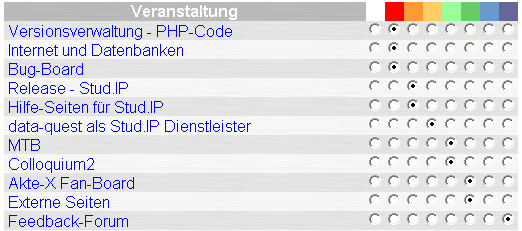Course overview
You will get to your courses via clicking on the symbol "My courses".

You can find an Overview for all your courses you are signed in.

The system does not know your schedule, you will just see the courses you are automatically signed up on - examples are the Feedback- and the Culture forum.
Another very useful feature, which can be used in the Course overview, is the possibility of arranging the courses that you have enrolled in into an individual sequence, in which you can subdivide them into up to eight different groups.
If you have not yet made a division into groups, a field with a semester color appears next to all the courses on the right side. This is useful when you have enrolled in several courses with the same name for several semesters; it aids you in rapidly distinguishing between them.
To change the arrangement, simply click on one of the fields next to the course titles or click on the chain icon in the top left corner:
Subsequently, an overview page is displayed, on which all courses are again listed. In addition, you will find a table on whose header the different colour fields can be seen. These make up eight different groups into which you can sort your courses.

Simply select a colour, which you consider to be appropriate, for each course.
Courses with the same colour will subsequently be grouped beneath one another in your course overview.
If you now click on Send, you exit to the Course overview page. All courses are now arranged in the groups that you just stipulated.
 You can change the division into groups at any time and generate the very interesting colour combinations as you desire — take a bit of time to play with the feature; rest assured, nothing can happen.
You can change the division into groups at any time and generate the very interesting colour combinations as you desire — take a bit of time to play with the feature; rest assured, nothing can happen.The Symbols, next to your courses, are shortcuts for different course options. If the symbols are red colored, that something changed in this course option, since your last visit or that something is new. When you click on the symbol you will get directly to the section of the course.
 With this icon you will get to the data file of this course.
With this icon you will get to the data file of this course.
 The bubble is for postings and contains the amount of forum dues.
The bubble is for postings and contains the amount of forum dues.
 This icon will lead you to the participants area of the course.
This icon will lead you to the participants area of the course.
 This sheet is the icon for documents and works like the icon for postings. It will show you the amount of dokuments or data files that are uploaded.
This sheet is the icon for documents and works like the icon for postings. It will show you the amount of dokuments or data files that are uploaded.
 This icon symbolises the announcements of the course. They could be very important because it could tell you something about changed rooms or similar information.
This icon symbolises the announcements of the course. They could be very important because it could tell you something about changed rooms or similar information.
 This icon occurs if the course contains an information page. This page can be designed by the lecturer individually.
This icon occurs if the course contains an information page. This page can be designed by the lecturer individually.
 The calendar sheet means, that the course has a specific date.
The calendar sheet means, that the course has a specific date.
 Due to this symbol you can identify that this course has its own Wiki.
Due to this symbol you can identify that this course has its own Wiki.
 The book will you to the bibliography. Here you can find recommended or interesting literatur for the courses topic.
The book will you to the bibliography. Here you can find recommended or interesting literatur for the courses topic.
This symbols are always there. It depends on the lecturers settings if the following symboles are available as well:
- surveys:

- learning mobuls:

- Blubber:

- DoIT:

- Mediacasts:

Each option you can reach in your course. Click on the requested course and choose the option from the register.
 With the exit symbol you can cancel the subscription of the course - you will not see the course on your overview page anymore. If you can not see that symbol you need to contact the tutors or letucers to leave the course. Or you are the lecturer itself.
With the exit symbol you can cancel the subscription of the course - you will not see the course on your overview page anymore. If you can not see that symbol you need to contact the tutors or letucers to leave the course. Or you are the lecturer itself. Cancel the subscription of the course with attention! In a data based system like Stud.IP there is no way back when you leave the course once.
Cancel the subscription of the course with attention! In a data based system like Stud.IP there is no way back when you leave the course once. At the end of the semester you should keep the course as well. Each course will be archived by an admin and you will not see it on your overview page- if you are still a participent of the course by that time, you can still reach the data during the archive.
Enter the course during clicking of the name.
The navigation of the course area corresponds to an index file with tabs.
There are main categories which are represented by the tabs. One tab is always active in the foreground (in this example Overview) and offers several subcategories (in this case: Brief information, Details, etc.)
You only reach the respective subcategories if you have previously activated the right tabs.
You change between the tabs and the subitems by clicking on the respective words.

